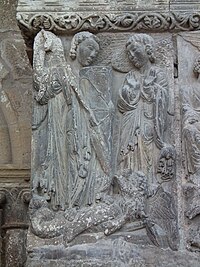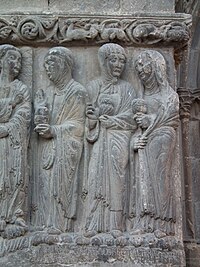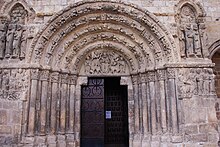San Miguel de Estella
San Miguel de Estella is a church in Estella-Lizarra , a Spanish city in the Navarra region .
Geographical location
The church is located on the summit of “La Mota”, a rocky steep slope that was ideal for defending the city.
history
The oldest surviving testimony of a parish that was consecrated to the Archangel Michael dates from 1145. The oldest remaining structural remains of the church are somewhat younger and date from the 1180s. The work on the building stretched over some time, so that different styles can be found here.
Building
The church is considered an outstanding example of the transition from Romanesque to Gothic in the Kingdom of Navarre .
Exterior

|

|
|
|
Archangel Michael stabs the dragon
|
On the outside of the church there is a small chapel of St. George, just a few meters east of the church choir and connected to it by a pointed arch.
Access to the interior of the church is through two portals on the two long sides. The southern one, dating from the 13th century, is very simply designed with archivolts supported by capitals decorated with stylized plants and a few small heads.
- North portal
The northern portal, on the other hand, is elaborately worked and of great art historical interest. The figurative decoration is "one of the most beautiful things that the late Romanesque [...] created along the pilgrimage route ". It dates from the end of the 12th century, other literature specifies more precisely “around 1185” or establishes two phases: the upper part older and forward, the lower parts younger and around 1185. The tympanum shows the Majestas Domini and the Annunciation of the Lord . The portal's sculpture also includes two bas-reliefs :
- Archangel Michael kills the dragon (left)
- The women at the grave (right)
The master who created the portal also worked on the Tudela Cathedral and Salamanca Cathedral . For conservation reasons, the portal is now enclosed in a glass protective building.
Interior
The building has three naves . Each of the ships ends with its own apse. The nave already shows early Gothic forms and is now presented in the forms of a renovation from the 16th century.
- Furnishing
The furnishings include a retable from the early 15th century, which shows Saint Helena in the main field .
literature
- Pedro de Palol et al. Max Hirmer: Spain. Art of the early Middle Ages from the Visigoth Empire to the end of the Romanesque period . Hirmer, Munich 1965.
- Kingsley Porter: Romanesque Sculpture of the Pilgrimage Roads . 3 volumes. Hacker Arts Books, New York, reprinted 1969.
- Claudia Rückert: The building sculpture of San Miguel in Estella (Navarra). Royal self-portrayal between innovation and tradition . Zabern, Mainz 2004. ISBN 978-3-8053-3430-3 .
- Werner Schäfke : Northwest Spain. Landscape, history and art on the way to Santiago de Compostela . DuMont, Cologne 1987, ISBN 3-7701-1589-9 .
- Pierre Tisné et al: Spain. Pictorial Atlas of Spanish Art . DuMont Schauberg, Cologne 1968, ISBN 3-7701-4461-9 .
Individual evidence
- ↑ Tisné: Spain , S. 254th
- ^ Schäfke: Northwest Spain , p. 74.
- ↑ Tisné: Spain , p 254; Schäfke: Northwest Spain , p. 74.
- ^ Porter: Romanesque Sculpture , p. 256.
- ^ Palol: Spain , p. 124.
- ^ Porter: Romanesque Sculpture , p. 256.
- ↑ Tisné: Spain , S. 254th
Coordinates: 42 ° 40 ′ 15.2 " N , 2 ° 1 ′ 41.8" W.


